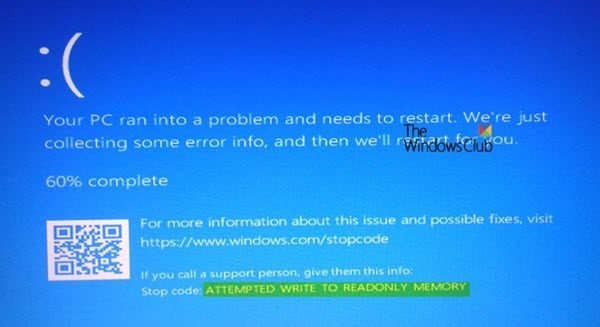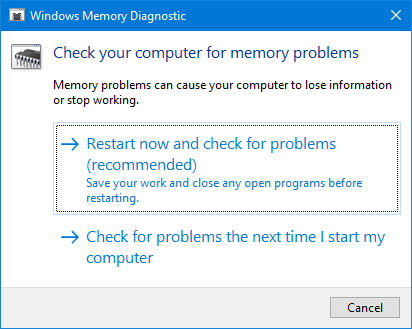The ATTEMPTED TO WRITE TO READ ONLY MEMORY Blue Screen has an error code 0x000000BE. This error occurs when you try to boot into Windows. There are various causes for the errors. Some of them are an error in a device driver, some hardware issues or an error within the BIOS of the computer. To fix this issue, there are various steps that you can undertake. But the main issue lies within booting into Windows because the error might occur as soon as you boot into Windows.

Fix 0x000000BE, ATTEMPTED TO WRITE TO READ ONLY MEMORY Blue Screen
The ATTEMPTED_WRITE_TO_READONLY_MEMORY bug check has a value of 0x000000BE. This is issued if a driver attempts to write to a read-only memory segment. If the driver responsible for the error can be identified, its name is printed on the blue screen and stored in memory at the location (PUNICODE_STRING) KiBugCheckDriver.
The following potential fixes can be carried out to fix ATTEMPTED_WRITE_TO_READONLY_MEMORY error on Windows 11/10:
-
- Update, Rollback or Disable Drivers.
- Run Memory Diagnostics.
- Update BIOS.
- Disable BIOS Memory Options.
- Run Blue Screen Troubleshooter.
I suggest that you boot Windows in Safe Mode and then carry out our suggestions, if possible.
1] Update, Rollback or Disable Drivers
This error is usually caused by the following files – iusb3hub.sys, ntkrnlpa exe or vhdmp.sys, ntoskrnl.exe, ntfs.sys, dxgkrnl.sys, tcpip.sys, atikmdag.sys, win32k.sys. So if you can identify the driver file causing this Stop Error, updating it or rolling back may help. Sometimes, the problematic driver is mentioned in the Blue Screen.
So, you can try to Update or Rollback the conflicting driver.
- Update your drivers via Optional Updates and see if it helps.
- If you recently updated a driver, maybe you could roll back the driver.
In particular, you can also try to update or uninstall/reinstall your Graphics Driver and see if it helps.
2] Run Memory Diagnostics

Run the Memory Check on your computer. Start by hitting the WINKEY + R button combination to launch the Run utility. Then type in, mdsched.exe and then hit Enter. It will launch the Windows Memory Diagnostic Tool and will give out two options-
- Restart now and check for problems (Recommended)
- Check for problems the next time I start my computer
Now, according to the option selected by you, the computer will restart and check for memory-based problems. If you get any issues there, it will fix it automatically else if no issues are detected, this is probably not the cause of the issue.
3] Update BIOS
Misconfigured or incompatible BIOS firmware might also be a cause resulting in the occurrence of this error. So, to fix it, you need to update the BIOS and see if that helps. Now, this is not something all can do – so you may need to take the help of an expert.
4] Disable BIOS Memory Options
To do this, you will have to enter your system’s BIOS, open the Advanced page, and you will see the options there. While in the BIOS, you will have to use the Arrow and the Enter keys to select your choices.
If you can’t find it, look for specific instructions from your OEM or in case you have a custom-built computer, look out for instructions from the maker of your motherboard.
5] Run Blue Screen Troubleshooter
You may also run the Blue Screen Troubleshooter. The Troubleshooter is easy to run and fixes BSODs automatically. The online Blue Screen Troubleshooter from Microsoft is a wizard that is meant to help novice users fix their Stop Errors. It offers helpful links along the way.
Let us know how it goes.